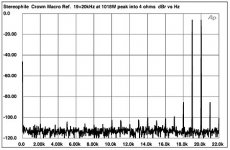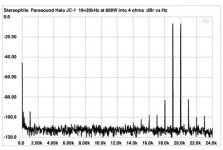Maybe John doesn't like THD rise above 2kHz, even at only 2.83V? 🙂
He said something about the importance of the high-order harmonics, so I took the remark serious and looked for a graph showing that. I didn't find it, so far.
Jan
Jan: There's a graph showing some higher order distortion products at under -100dB with 800W flowing. Clearly a major concern. 😀
The measurements descriptions indicated that the residual at lower powers was just noise. The only things the amp lacked were a logo from someone on the Team, a fanciful story, and a royalty check for John.
The measurements descriptions indicated that the residual at lower powers was just noise. The only things the amp lacked were a logo from someone on the Team, a fanciful story, and a royalty check for John.
The thing we all must have noticed is that when it suits the Team, they point to harmonics graphs as proof that the amp is Horrible. When it doesn't suit them they declare that measurements don't tell anything about sound quality....
Jan
Jan
In fairness it looks like this whole forum refers to some kind of measurements though, the dividing line seems mostly when it becomes mystical or overkill measurements?
Like, Silver cables and electron transmission, time error, 0.00001% harmonic / intermodulation distortion, glitch error in DAC's, mechanical resonance.
I mean, it looks like most people are actually on the same page here, to me at least.
Hi-Fi stores full of hundreds of valves and Rhodium-plated AC sockets is a different story, the "we like the sound of x/y/z distortion" school.
Just sharing my viewpoint.
Like, Silver cables and electron transmission, time error, 0.00001% harmonic / intermodulation distortion, glitch error in DAC's, mechanical resonance.
I mean, it looks like most people are actually on the same page here, to me at least.
Hi-Fi stores full of hundreds of valves and Rhodium-plated AC sockets is a different story, the "we like the sound of x/y/z distortion" school.
Just sharing my viewpoint.
And it is all because all that darned NFB.
Of course, don't you know? Feedback is good enough to keep fighter planes from falling down, keep nuclear power plants from exploding, keeps humans breathing, but you can't trust it with something as critical as a power amp! 😎
Jan
No, it is not the negative feedback that is at issue, but the crossover distortion as implied by the higher order distortion generated.
I have a limited set of distortion measurements to judge the performance of this amp. Higher order is what I suspect. It may be just the test equipment, hard to tell.
You have a "limited set of measurements" and didn't read the text, so that's all you need to jump to a convenient conclusion in order to slam a competitor.
Check.
Check.
Feedback can hide potential problems. John Curl, 'audio design chimp'. I am proud to be a 'chimp' along with the Stereophile reviewers.
No, it is not the negative feedback that is at issue
Feedback can hide potential problems.
Figure out which story you want to tell. That sort of dancing can give you whiplash.
Twice the power for the Crown, which also shows lower IMD, though both are at levels unlikely to be audible.
It's like a snake. no it's like a wall, no it's like a tree, no it's a rope and when you pull it...
it is very easy to get very poor sound quality out of most of the older Crown Audio amplifiers. If you look at the schematic the output stage has current limit protection. As these amplifiers are capable of producing massive amounts of current they run into problems smaller amplifiers do not. Most all consumer and even pro loudspeakers used ferrite or even iron core inductors. These are fine until they saturate with high power at low frequencies. Then they behave like a short circuit. This activates the current limiters and quite simply they squeege (Burst oscillation of varying frequency.) Now if you have a system that can actually handle the power you can hear it quite distinctly. On smaller loudspeakers the actual noise doesn't stand out by itself, things just don't sound as clear. As the ear is relatively insensitive to low frequency noise such as record warp it was not obvious what was degrading the reproduction quality.
...out comes pollution.
Now who cares about distortion measurements at full power? When it is that loud the loudspeakers ain't exactly linear. Show me .1 watt!
it is very easy to get very poor sound quality out of most of the older Crown Audio amplifiers. If you look at the schematic the output stage has current limit protection. As these amplifiers are capable of producing massive amounts of current they run into problems smaller amplifiers do not. Most all consumer and even pro loudspeakers used ferrite or even iron core inductors. These are fine until they saturate with high power at low frequencies. Then they behave like a short circuit. This activates the current limiters and quite simply they squeege (Burst oscillation of varying frequency.) Now if you have a system that can actually handle the power you can hear it quite distinctly. On smaller loudspeakers the actual noise doesn't stand out by itself, things just don't sound as clear. As the ear is relatively insensitive to low frequency noise such as record warp it was not obvious what was degrading the reproduction quality.
...out comes pollution.
Now who cares about distortion measurements at full power? When it is that loud the loudspeakers ain't exactly linear. Show me .1 watt!
Last edited:
Scott,
Let's be fair, Crown has produced a few reasonable "audiophile" power-amplifiers; their Macro Reference got a fairly positive review in Stereophile (Crown Macro Reference power amplifier | Stereophile.com)
That comment was in the same spirit as using uA741's to criticize op-amps as a technology. I think the less time spent rehashing what people had not figured out 40yr. ago the better.
That comment was in the same spirit as using uA741's to criticize op-amps as a technology. I think the less time spent rehashing what people had not figured out 40yr. ago the better.
I did get an end of life notice for uA709s! I doubt that will happen for 741s! But how about that uA703! Way better than a 2N170 for I.F. use!
Since the second plot does not sufficiently specify the power it is hard to tell. One would have assume they are both peak?What is the essential difference between these two measurements? Look carefully now. '-)
What is the essential difference between these two measurements? Look carefully now. '-)
Higher IMD and higher sidebands for the Parasound?
Looking at these graphs, the Crown runs circles around the Parasound.
Or am I missing something?
Last edited:
If you look at the schematic the output stage has current limit protection.
That I agree most probably is a major point to sound quality (or lack thereof) with real world speaker loads! And something you won't see in any of the graphs that were shown.
Didn't we agree last century that measurements say squat about sound quality? And now even JC starts comparing IMD graphs!
Confused in Belgium,
Jan
- Status
- Not open for further replies.
- Home
- Member Areas
- The Lounge
- John Curl's Blowtorch preamplifier part II

